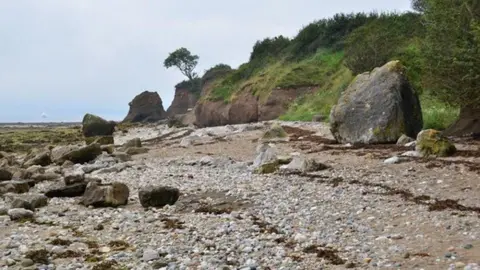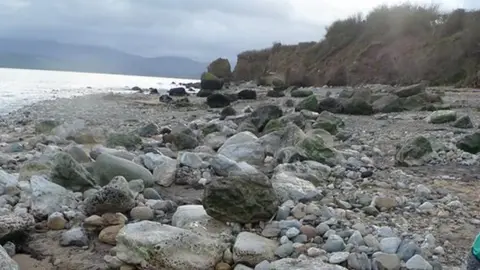Ice Age evidence bulldozed from Lleiniog beach
 Gareth Phillips
Gareth PhillipsA "critically important" site of scientific interest has been "destroyed" by council workers on an Anglesey beach, it has been claimed.
Huge boulders dating back to the end of the last Ice Age were moved as flood relief work was carried out on Lleiniog beach at Llangoed, residents said.
They also claimed post-glacial peat beds were ruined by bulldozers.
Natural Resources Wales said it was investigating but Anglesey council said it had a licence for the work.
Gareth Phillips, a member of Friends of Llangoed Community Group, said: "It's one of the most daft and tragic things I have ever seen done in the UK."
 Gareth Phillips
Gareth PhillipsLleiniog beach, which runs along the Anglesey shore of the Menai Strait, was strewn with huge boulders which gave vital information on how glaciers behaved.
Natural Resources Wales says the site provides "some of the clearest evidence in north Wales for an incursion of Irish Sea ice during the Late Pleistocene", the last Ice Age.
It describes Lleiniog as an important site for studies of the quaternary period, the most recent period in geological time when the Ice Age occurred.
Anglesey county council workers had a licence to clear out the mouth of a small river to prevent flooding of a nearby road.
 Gareth Phillips
Gareth PhillipsBut after working on the mouth of the stream, "they went down 200 yards on the beach and scooped up boulders of scientific interest", Mr Phillips said.
"They had no reason and no licence to be there," said the retired health professional with a keen interest in archaeology and geology. "The local community has been distraught about it."
Euros Jones, operations manager for north west Wales at Natural Resources Wales, said the Welsh Government and Natural Resources Wales were investigating reports of damage to the site and looking into whether the work breached the conditions of the licence.
It is also investigating whether the works damaged important features of the site.
An Isle of Anglesey County Council spokesperson said: "A Marine Licence from Natural Resources Wales was in place to undertake these works. We also confirmed to Gwynedd Archaeological Planning Service that we were not working in the area marked protected on their maps referencing the scheduled monument fish weirs."
